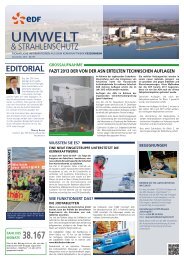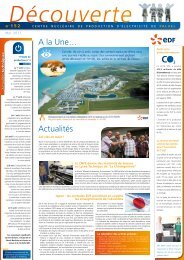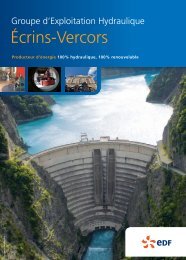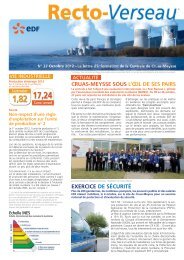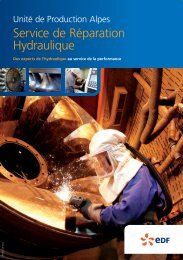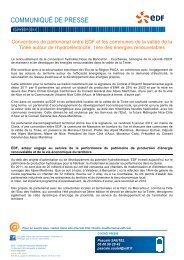on Nuclear Safety and Radiation Protection - Energie EDF
on Nuclear Safety and Radiation Protection - Energie EDF
on Nuclear Safety and Radiation Protection - Energie EDF
You also want an ePaper? Increase the reach of your titles
YUMPU automatically turns print PDFs into web optimized ePapers that Google loves.
A DIAGNOSIS ERROR DURING START-UP<br />
The facts<br />
The annual outage for maintenance <strong>and</strong> refuelling was<br />
coming to a close <strong>and</strong> start-up was beginning. The reactor<br />
pressure vessel was closed, the core was still sub-critical,<br />
the pressure in the reactor coolant system was 3 bar, the<br />
primary coolant pumps were stopped <strong>and</strong> venting of the<br />
reactor coolant system was in progress.<br />
At the end of the afterno<strong>on</strong> shift at around 20:00, the<br />
c<strong>on</strong>trol room operators noticed a drop in the level of the<br />
chemical <strong>and</strong> volume c<strong>on</strong>trol tank for the reactor coolant<br />
system, which they interpreted as being due to a primary<br />
coolant outflow <strong>and</strong> estimated it at 5 m3/h. Actually,<br />
the venting operati<strong>on</strong>s performed that afterno<strong>on</strong> had<br />
destabilised the pressure regulati<strong>on</strong> acti<strong>on</strong> of the chemical<br />
<strong>and</strong> volume c<strong>on</strong>trol valve of the reactor coolant system, a<br />
phenomen<strong>on</strong> of which the operators were unaware.<br />
They saw neither a change in the levels of the reactor<br />
building sumps, nor in the charging <strong>and</strong> letdown flows.<br />
Unable to explain the chemical <strong>and</strong> volume c<strong>on</strong>trol tank<br />
level change after analysis, it was c<strong>on</strong>sidered that <strong>on</strong>e<br />
of the nuclear steam supply system parameters was not<br />
under c<strong>on</strong>trol, indicating the need to operate the reactor<br />
in accordance with an incident situati<strong>on</strong> procedure using<br />
what is termed as a symptom-based approach. The<br />
operati<strong>on</strong>s team applied the procedure <strong>and</strong> alerted both<br />
the safety engineer <strong>and</strong> the duty Emergency C<strong>on</strong>troller<br />
(known as PCD1 in France).<br />
Between 20:00 <strong>and</strong> 21:00, the c<strong>on</strong>trol room shift changed.<br />
In accordance with the procedures, the operators manually<br />
started the low-pressure safety injecti<strong>on</strong> pumps to<br />
compensate for the loss of primary coolant. The automatic<br />
protecti<strong>on</strong> functi<strong>on</strong> isolated the c<strong>on</strong>tainment, resulting<br />
in isolati<strong>on</strong> of the main reactor coolant system makeup<br />
lines. As a result of the absence of an actual outflow<br />
from the nuclear steam supply system <strong>and</strong> the starting<br />
of the low-pressure safety injecti<strong>on</strong>, the pressure in the<br />
reactor coolant system rose to around 10 bar as injecti<strong>on</strong>s<br />
at the reactor coolant pumps seals were maintained. The<br />
incoming operati<strong>on</strong>s shift manager then decided to stop<br />
injecti<strong>on</strong> at the reactor coolant pump seals so the decay<br />
heat removal system safety valves would not open.<br />
Meanwhile, the PCD1 decided to muster the plant<br />
emergency resp<strong>on</strong>se team capable of dealing with such<br />
a case. In the c<strong>on</strong>trol room, the outgoing team stayed to<br />
support the incoming team, <strong>and</strong> the two operating shift<br />
managers were present at the same time.<br />
At 21:10, applicati<strong>on</strong> of the symptom-based approach<br />
resulted in opening the zero-flow valves of the lowpressure<br />
safety injecti<strong>on</strong> pumps to the safety injecti<strong>on</strong><br />
NOTEWORTHY OPERATING EVENTS<br />
THE INSPECTOR GENERAL’S REPORT<br />
ON NUCLEAR SAFETY AND RADIATION PROTECTION<br />
sumps inside the reactor building. Five minutes later, the<br />
operators in the c<strong>on</strong>trol room observed that the level in<br />
the reactor coolant tank (PTR) was dropping <strong>and</strong> the levels<br />
in the reactor building sumps were corresp<strong>on</strong>dingly rising.<br />
This valve opening led to an outflow of some 120 m3 into<br />
the sumps.<br />
Around 21:40, the operati<strong>on</strong>s shift manager decided<br />
to send a team into the reactor building to identify the<br />
reas<strong>on</strong> for the flow of coolant into the sumps, <strong>and</strong> it was<br />
so<strong>on</strong> determined that it was the safety injecti<strong>on</strong> systems<br />
sump levels that were affected.<br />
The PCD1, in the c<strong>on</strong>trol room around 22:00, assessed the<br />
situati<strong>on</strong> with the two operating shift managers present.<br />
He c<strong>on</strong>firmed that the incoming operating shift manager<br />
was the <strong>on</strong>e in charge of operati<strong>on</strong>s. The latter suggested<br />
closing the zero-flow lines valves of the low-pressure<br />
safety injecti<strong>on</strong> pumps. The strategy was adopted <strong>and</strong> the<br />
level in the reactor coolant system tank rapidly stabilised.<br />
At 22:30, the parameters had stabilised <strong>and</strong> the integrity<br />
of the reactor coolant system was c<strong>on</strong>firmed. The lowpressure<br />
safety injecti<strong>on</strong> pumps were stopped.<br />
The operating team exited the incident. procedure<br />
in the middle of the night shift as the primary coolant<br />
balance had returned to c<strong>on</strong>formity with the technical<br />
specificati<strong>on</strong>s for operati<strong>on</strong>.<br />
My analysis<br />
• An error of diagnosis<br />
The decisi<strong>on</strong> to operate the reactor using incident<br />
<strong>and</strong> accident situati<strong>on</strong> procedures resulted in an<br />
error of diagnosis by the operati<strong>on</strong>s teams, who<br />
mistakenly believed that there was a primary coolant<br />
leak. I would like to point out that the team, in<br />
difficult circumstances, re-established functi<strong>on</strong>ing<br />
in accordance with the technical specificati<strong>on</strong>s for<br />
operati<strong>on</strong>, adapting the incident situati<strong>on</strong> procedures<br />
to the events as they occurred.<br />
• Lack of mastery of physical phenomena<br />
I observe that the physical phenomena involved<br />
in this event are rarely encountered in operati<strong>on</strong>s<br />
<strong>and</strong> the operating staff <strong>and</strong> their technical advisers<br />
found it hard to h<strong>and</strong>le them although they were<br />
all experienced. It would also appear that too much<br />
c<strong>on</strong>fidence is being placed in leak balance calculati<strong>on</strong>s<br />
carried out under abnormal thermal-hydraulic<br />
c<strong>on</strong>diti<strong>on</strong>s <strong>and</strong> there is insufficient awareness of the<br />
uncertainty of the calculati<strong>on</strong>s for such situati<strong>on</strong>s.<br />
Also, the procedure c<strong>on</strong>tained no warnings about the<br />
risk of making too much of a somewhat unreliable<br />
result.<br />
75



